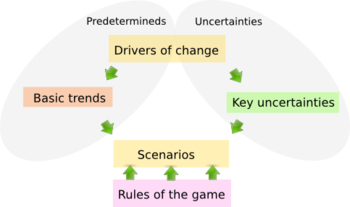Trends
| Scenario planning for educators | |
|---|---|
| Drivers of fundamental change | Introduction and objectives | Video signposts | Trends | Uncertainties | e-Learning Activity - Scenario matrix | FAQs |
Contents
Overview
Drivers of change push (or pull) organisations away from a “business as usual” and include trends where the direction of the outcome is reasonably predictable based on historical data. Trends can contribute to both fundamental and incremental change.
Reviewing contemporary trends in education can help us "to identify and prepare for the future that has already happened" (Drucker 1998[1]). In this subsection we will begin to brainstorm drivers of change relevant to your context. We will review reports from the Horizon Project published by the New Media Consortium (NMC) and conduct web searches on drivers of change in education.
We will focus on trends during this subsection, in other words those drivers of change where the "direction" of the outcome is reasonably predictable.
The interplay between trends and uncertainties
Consider for example, the uptake in accessing websites using mobile devices. It is conceivable that mobile learning could have a major impact on how we design and deliver learning in the future. However, the direction of the trend is predictable, namely that historical data indicates that we should see continued growth in the number of users accessing the Internet using mobile devices. In this regard, the growth in using mobile devices to access the web is not "fundamentally unknown" in the sense of an uncertainty for defining the scenario matrix for building a deductive scenario. Nonetheless, how mobile learning will impact on changes in teaching and learning could conceivably be "unkown" for the purposes of scenario planning.When identifying a drivers of change in your own context, you will need to think about the following questions:
- Is the general direction or trend of the factor reasonably known or predictable?
- Will the factor have a major impact on the way we do business today?
- Is the outcome of the factor unknown? If so, the factor is probably an uncertainty if it pushes (or pulls) the organisation away from a “business as usual”.
What do you think?
| Initial brainstorm of the drivers of change in education
Drawing on your own context and experience, what are the trends that are driving change in education? Share your thoughts by posting on twitter or WEnotes. Remember to include the #SP4Ed tag in your post, for example:
|
What do others think?
In this subsection, participants will research and identify two or three major trends that will have an impact on the way we do business today. We start with a few suggested readings and then invite you to conduct your own web search to identify major trends. We will conclude with an initial reflection on what you believe to be the important trends for your own context.
| Resources to get started on identifying trends The NMC Horizon Project charts the landscape of emerging technologies for teaching, learning, research, creative inquiry, and information management. Each year NMC publish reports on technologies to watch on three adoption horizons: namely near-term (within the next year), mid-term (within two to three years) and far-term (four to five years). Scenario planning as a strategic methodology aims to focus on the longer term horizon.
Task Are there any long-term trends which you think are relevant to your own sector and context? Jot these down as inputs for the next phase. |
| Desktop research
Spend about 30 to 45 minutes conducting a web search on drivers of change in education. Scan the websites which attract your interest and if you identify a trend which is relevant to your context, jot this down and bookmark the relevant page in your browser for later reference. |
Sharing the trends you identified
Identify two or three major trends which are relevant to your context
|
Notes
- ↑ Drucker, P.F. 1998. The future that has already happened. Futurist. 32(8): 16-19.

